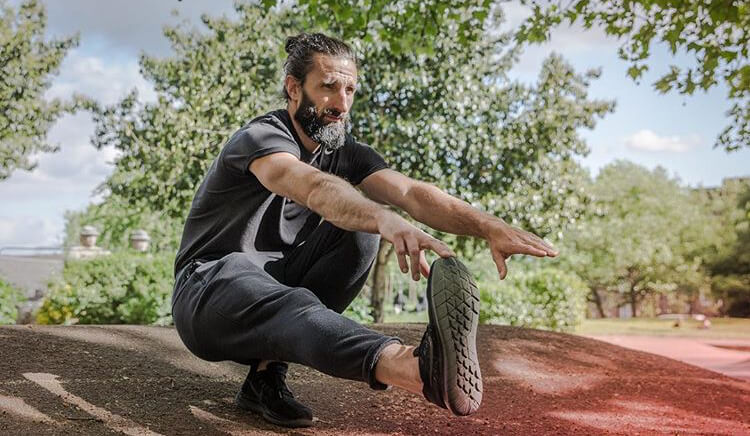Why do physios and doctors often advise yoga and Pilates when you’ve injured your back? Couldn’t you just do stretching at home instead? No. Because yoga and Pilates aren’t just about stretching, and better flexibility alone is not going to improve your back. What you need to work on is your control. Doing so can help you prevent many different types of injuries and improve your performance.
Both yoga and Pilates are control-based types of training that lead to an overall improvement in postural function and mental wellbeing. Control-based exercises are controlled movements that optimize the way you load your joints. They make sure you’re engaging the right muscles for the movement, rather than compensating by using your stronger muscles, or doing the movement in a way that stresses the muscles and ligaments around that joint, or structures in other parts of your body. You could say that there is no ‘wrong’ way of moving, as long as it is controlled.
Yoga and Pilates aren’t for everyone, and luckily control-based training methods are becoming more popular and come in different forms. Think kettle bell training, TrX, calisthenics and Animal Flow.
In clinic, we see many injuries, other than back injuries, that have developed from a lack of control. That’s why as physiotherapists, we recommend control-based exercise to many of our patients. Not only as part of a rehabilitation, but to prevent injuries.
Following an injury the rehabilitation process usually requires that you work on these things in this order:
These will overlap somewhat. For example, you can already start building strength while you’re still working on your flexibility, mobility and stability.
But let’s go back to the first thing on the list – flexibility.
Flexibility refers to the range of movement through which a joint can be passively moved. Your flexibility is affected by the length of the muscle’s fascicles (the muscle fibre bundles) and the consistency of the collagen in your soft tissues. If you’re hypermobile, you’ll tend to have more movement in your joints in part because of weakness in collagen consistency. This is usually down to your genetics. When you have a greater range of motion, and you don’t have the control, your movements will be all over the place and your muscles will stiffen up to protect the joint. This reduces your mobility, which is the ability to actively move your joint through a certain range.
That’s why control-based training is advisable for people with hypermobility, but equally for those with ‘regular’ flexibility. When you lack control, you’re more likely to develop muscle stiffness. If you’re just lifting weights, and not incorporating thoughtful and controlled movements, you are more likely to become tighter and/or strain a muscle during a sudden movement.

The same goes for strength and power. When you have no control, you lose energy to unnecessary movements. If the movement is controlled, maximum energy goes into output, – the force with which you can hit or kick a ball for example. If you have a good range for the movement, you can build up more energy. Put the two together, add speed of movement, and you have the optimal output in terms of strength and power.
Think of a pitcher throwing a baseball. For the ball to go as far and as fast as possible, they will need to bring their arm far back and also maintain contact with the ball for as long as possible. If they move a shorter distance with their arm and let go of the ball earlier, the throw won’t go as far. The movement also needs to flow in a straight curve, so that there are no small movements that cause a shift in direction and cause loss of energy.
Interestingly, the current evidence tells us that static stretching may only increase the tolerance of your muscle to being stretched, rather than actually lengthening the muscle fascicles. There is more support for dynamic stretching, but it seems that eccentric strengthening exercises – when a muscle is lengthening with control – influences muscle fascicle length, thereby increasing flexibility.
Are your hips always stiff? Do you carry a lot of tightness around a shoulder joint? Foam rolling and massage are great tools – and may have a (temporary) effect on tightness. But it might be worth assessing your movement patterns to see where improvements can be made. Adding some control-based exercises to your training routine will have a more significant impact on your tightness and your performance in the long run.
Barbosa GM, Trajano GS, Dantas GAF, Silva BR, Vieira WHB. Chronic Effects of Static and Dynamic Stretching on Hamstrings Eccentric Strength and Functional Performance: A Randomized Controlled Trial [published online ahead of print, 2019 Feb 14]. J Strength Cond Res. 2019;10.1519/JSC.0000000000003080. doi:10.1519/JSC.0000000000003080
Weppler CH, Magnusson SP. Increasing muscle extensibility: a matter of increasing length or modifying sensation?. Phys Ther. 2010;90(3):438–449. doi:10.2522/ptj.20090012.
Konrad A, Tilp M. Increased range of motion after static stretching is not due to changes in muscle and tendon structures. Clin Biomech (Bristol, Avon). 2014;29(6):636–642. doi:10.1016/j.clinbiomech.2014.04.013.
Delvaux F, Schwartz C, Decréquy T, et al. Influence of a Field Hamstring Eccentric Training on Muscle Strength and Flexibility [published online ahead of print, 2020 Jan 14]. Int J Sports Med. 2020;10.1055/a-1073-7809. doi:10.1055/a-1073-7809.
O'Sullivan K, McAulliffe S, DeBurca N. THE EFFECTS OF ECCENTRIC TRAINING ON LOWER LIMB FLEXIBILITY: A SYSTEMATIC REVIEW. British Journal of Sports Medicine 2014;48:648.
Abdel-Aziem AA, Soliman ES, Abdelraouf OR. Isokinetic peak torque and flexibility changes of the hamstring muscles after eccentric training: Trained versus untrained subjects. Acta Orthop Traumatol Turc. 2018;52(4):308–314. doi:10.1016/j.aott.2018.05.003.
Nelson RT. A Comparison of the Immediate Effects of Eccentric Training vs Static Stretch on Hamstring Flexibility in High School and College Athletes. N Am J Sports Phys Ther. 2006;1(2):56–61.
Su H, Chang NJ, Wu WL, Guo LY, Chu IH. Acute Effects of Foam Rolling, Static Stretching, and Dynamic Stretching During Warm-ups on Muscular Flexibility and Strength in Young Adults. J Sport Rehabil. 2017;26(6):469–477. doi:10.1123/jsr.2016-0102.